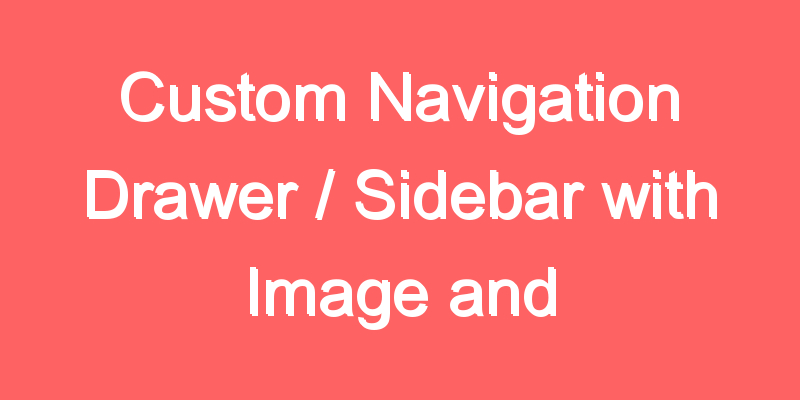Custom Navigation Drawer / Sidebar with Image and Icon in Menu Options

This is an example of Custom Navigation Drawer / Sidebar with Image and Icon in Menu Options with React Navigation. We will use react-navigation@3.11.1 to make a navigation drawer in this example. I hope you have already seen our last post on React Native Navigation Drawer as this post is the extended version of React Native Navigation Drawer.
In this example, we have a navigation drawer with 3 screens in the navigation menu. We will make the custom sidebar in place of the simple navigation drawer so that we can modify the Navigation Drawer menu options according to our needs.
In the custom Sidebar, we will have a React image and an array of option name with the icon and there targeted navigation screen. With the help of a loop and this array, we will make N number of options with an icon in the Navigation Drawer.
We are going to use contentComponent prop of createDrawerNavigator to set our custom view which is CustomSidebarMenu.js in this example.
Install react-navigation dependency to import createAppContainer. If you install react-navigation@3.11.1 then createDrawerNavigator and createStackNavigator present inside the react-navigation. Otherwise you have to install independently other dependencies.
npm install react-navigation --save2. Other supporting libraries for react-navigation
npx npm install react-native-gesture-handler react-native-safe-area-context @react-native-community/masked-view react-native-screens react-native-reanimated --save3. Install react-navigation-drawer to import createDrawerNavigator
npm install react-navigation-drawer --saveThese steps are enough for the drawer navigation but in this example, we are also using createStackNavigator to switch screens, so please follow the next step also
4. Install react-navigation-stack to import createStackNavigator
npm install react-navigation-stack --saveThese commands will copy all the dependencies into your node_module directory.
CocoaPods Installation
Please use the following command to install CocoaPods
cd ios && pod install && cd ..For the Icons, install react-native-elements
npm install react-native-elements –save
npm install react-native-vector-icons –save
After that we have to link the vector icons to our project.
react-native link react-native-vector-icons
Project Structure
To start with this Example you need to create a directory named pages in your project and create three files Screen1.js, Screen2.js, and Screen3.js in it.
To have the drawer Icon in Action Bar you have to make an image directory in your project and have to copy any drawer image with name drawer.png (For this example. You can change if you want but you need to change the file name in code too).
For the custom sidebar, make a file called CustomSidebarMenu.js in the project directory (not in the pages directory)


App.js
//This is an example code for Navigation Drawer with Custom Side bar//
import React, { Component } from 'react';
//import react in our code.
import {
View,
StyleSheet,
Dimensions,
Image,
TouchableOpacity,
Platform,
Text,
} from 'react-native';
// import all basic components
//Import React Navigation
import {createAppContainer,createDrawerNavigator,createStackNavigator} from 'react-navigation';
//Import all the screens
import Screen1 from './pages/Screen1';
import Screen2 from './pages/Screen2';
import Screen3 from './pages/Screen3';
//Import Custom Sidebar
import CustomSidebarMenu from './CustomSidebarMenu';
global.currentScreenIndex = 0;
//Navigation Drawer Structure for all screen
class NavigationDrawerStructure extends Component {
//Top Navigation Header with Donute Button
toggleDrawer = () => {
//Props to open/close the drawer
this.props.navigationProps.toggleDrawer();
};
render() {
return (
<View style={{ flexDirection: 'row' }}>
<TouchableOpacity onPress={this.toggleDrawer.bind(this)}>
{/*Donute Button Image */}
<Image
source={require('./image/drawer.png')}
style={{ width: 25, height: 25, marginLeft: 5 }}
/>
</TouchableOpacity>
</View>
);
}
}
//Stack Navigator for the First Option of Navigation Drawer
const FirstActivity_StackNavigator = createStackNavigator({
//All the screen from the First Option will be indexed here
First: {
screen: Screen1,
navigationOptions: ({ navigation }) => ({
title: 'Demo Screen 1',
headerLeft: ()=> <NavigationDrawerStructure navigationProps={navigation} />,
headerStyle: {
backgroundColor: '#FF9800',
},
headerTintColor: '#fff',
}),
},
});
//Stack Navigator for the Second Option of Navigation Drawer
const Screen2_StackNavigator = createStackNavigator({
//All the screen from the Second Option will be indexed here
Second: {
screen: Screen2,
navigationOptions: ({ navigation }) => ({
title: 'Demo Screen 2',
headerLeft: ()=> <NavigationDrawerStructure navigationProps={navigation} />,
headerStyle: {
backgroundColor: '#FF9800',
},
headerTintColor: '#fff',
}),
},
});
//Stack Navigator for the Third Option of Navigation Drawer
const Screen3_StackNavigator = createStackNavigator({
//All the screen from the Third Option will be indexed here
Third: {
screen: Screen3,
navigationOptions: ({ navigation }) => ({
title: 'Demo Screen 3',
headerLeft: ()=> <NavigationDrawerStructure navigationProps={navigation} />,
headerStyle: {
backgroundColor: '#FF9800',
},
headerTintColor: '#fff',
}),
},
});
//Drawer Navigator Which will provide the structure of our App
const DrawerNavigatorExample = createDrawerNavigator(
{
//Drawer Optons and indexing
NavScreen1: {
screen: FirstActivity_StackNavigator,
navigationOptions: {
drawerLabel: 'Demo Screen 1',
},
},
NavScreen2: {
screen: Screen2_StackNavigator,
navigationOptions: {
drawerLabel: 'Demo Screen 2',
},
},
NavScreen3: {
screen: Screen3_StackNavigator,
navigationOptions: {
drawerLabel: 'Demo Screen 3',
},
},
},
{
//For the Custom sidebar menu we have to provide our CustomSidebarMenu
contentComponent: CustomSidebarMenu,
//Sidebar width
drawerWidth: Dimensions.get('window').width - 130,
}
);
export default createAppContainer(DrawerNavigatorExample);Screen1.js
//This is an example code for Navigation Drawer with Custom Side bar//
import React, { Component } from 'react';
//import react in our code.
import { StyleSheet, View, Text } from 'react-native';
// import all basic components
export default class Screen1 extends Component {
//Screen1 Component
render() {
return (
<View style={styles.MainContainer}>
<Text style={{ fontSize: 23 }}> Screen {global.currentScreenIndex + 1} </Text>
</View>
);
}
}
const styles = StyleSheet.create({
MainContainer: {
flex: 1,
paddingTop: 20,
alignItems: 'center',
marginTop: 50,
justifyContent: 'center',
},
});Screen2.js
//This is an example code for Navigation Drawer with Custom Side bar//
import React, { Component } from 'react';
//import react in our code.
import { StyleSheet, View, Text } from 'react-native';
// import all basic components
export default class Screen2 extends Component {
//Screen2 Component
render() {
return (
<View style={styles.MainContainer}>
<Text style={{ fontSize: 23 }}> Screen {global.currentScreenIndex + 1} </Text>
</View>
);
}
}
const styles = StyleSheet.create({
MainContainer: {
flex: 1,
paddingTop: 20,
alignItems: 'center',
marginTop: 50,
justifyContent: 'center',
},
});Screen3.js
//This is an example code for Navigation Drawer with Custom Side bar//
import React, { Component } from 'react';
//import react in our code.
import { StyleSheet, View, Text } from 'react-native';
// import all basic components
export default class Screen3 extends Component {
//Screen3 Component
render() {
return (
<View style={styles.MainContainer}>
<Text style={{ fontSize: 23 }}> Screen {global.currentScreenIndex + 1} </Text>
</View>
);
}
}
const styles = StyleSheet.create({
MainContainer: {
flex: 1,
paddingTop: 20,
alignItems: 'center',
marginTop: 50,
justifyContent: 'center',
},
});CustomSidebarMenu.js
(Custom Menu with large profile Image and Options with options)
//This is an example code for Navigation Drawer with Custom Side bar//
import React, { Component } from 'react';
import { View, StyleSheet, Image, Text } from 'react-native';
import { Icon } from 'react-native-elements';
export default class CustomSidebarMenu extends Component {
constructor() {
super();
//Setting up the Main Top Large Image of the Custom Sidebar
this.proileImage =
'https://codehunger.com/image.png';
//Array of the sidebar navigation option with icon and screen to navigate
//This screens can be any screen defined in Drawer Navigator in App.js
//You can find the Icons from here https://material.io/tools/icons/
this.items = [
{
navOptionThumb: 'camera',
navOptionName: 'First Screen',
screenToNavigate: 'NavScreen1',
},
{
navOptionThumb: 'image',
navOptionName: 'Second Screen',
screenToNavigate: 'NavScreen2',
},
{
navOptionThumb: 'build',
navOptionName: 'Third Screen',
screenToNavigate: 'NavScreen3',
},
];
}
render() {
return (
<View style={styles.sideMenuContainer}>
{/*Top Large Image */}
<Image
source={{ uri: this.proileImage }}
style={styles.sideMenuProfileIcon}
/>
{/*Divider between Top Image and Sidebar Option*/}
<View
style={{
width: '100%',
height: 1,
backgroundColor: '#e2e2e2',
marginTop: 15,
}}
/>
{/*Setting up Navigation Options from option array using loop*/}
<View style={{ width: '100%' }}>
{this.items.map((item, key) => (
<View
style={{
flexDirection: 'row',
alignItems: 'center',
paddingTop: 10,
paddingBottom: 10,
backgroundColor: global.currentScreenIndex === key ? '#e0dbdb' : '#ffffff',
}}
key={key}>
<View style={{ marginRight: 10, marginLeft: 20 }}>
<Icon name={item.navOptionThumb} size={25} color="#808080" />
</View>
<Text
style={{
fontSize: 15,
color: global.currentScreenIndex === key ? 'red' : 'black',
}}
onPress={() => {
global.currentScreenIndex = key;
this.props.navigation.navigate(item.screenToNavigate);
}}>
{item.navOptionName}
</Text>
</View>
))}
</View>
</View>
);
}
}
const styles = StyleSheet.create({
sideMenuContainer: {
width: '100%',
height: '100%',
backgroundColor: '#fff',
alignItems: 'center',
paddingTop: 20,
},
sideMenuProfileIcon: {
resizeMode: 'center',
width: 150,
height: 150,
marginTop: 20,
borderRadius: 150 / 2,
},
});Then run the project using the command npm start if you are using expo tools.









